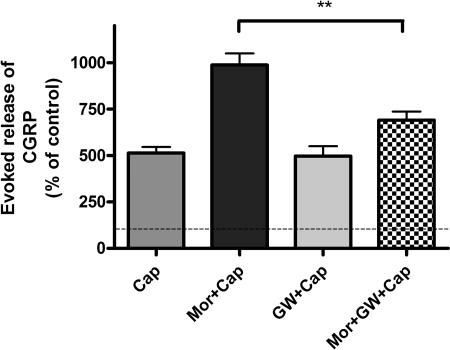Fig. 7.
The selective Raf-1 inhibitor GW5074 attenuates sustained morphine-mediated augmentation of capsaicin-evoked CGRP release from neonatal rat DRG neurons. Cap, capsaicin (1 μM) treatment (10 min) of neonatal rat DRG neurons evokes CGRP release to 514 ± 33% basal (n = 5). Mor + Cap, sustained morphine (1 μM) treatment augmented capsaicin-evoked CGRP release by 92% (989 ± 62% basal, ***, p < 0.001 relative to Cap, one-way ANOVA; n = 5). Mor + GW + Cap, pretreatment (1 h) of the cells with GW5074 (10 μM), followed by 24-h coincubation in the presence of morphine (1 μM), attenuated capsaicin (1 μM; 10 min)-evoked CGRP release to 691 ± 47% basal, which is a 67% reduction of CGRP release to that of Mor + Cap group (**, p < 0.01, one-way ANOVA; n = 5). GW + Cap, treatment of the DRG neurons with GW5074 (10 μM) alone had no effect on capsaicin-evoked CGRP release [498 ± 53% basal, p > 0.05 to Cap (514 ± 33% basal), one-way ANOVA; n = 5]. The results (mean ± S.E.M.) are expressed as the percentage of basal CGRP release from unstimulated DRG neurons.

